
Start of Ethereum Fork Technologies Quiz
1. What is a fork in the context of Ethereum?
- A fork is a new type of cryptocurrency that operates independently from the original.
- A fork is a temporary disruption in the network that automatically resolves itself.
- A fork is an agreement among miners to stop validating transactions.
- A fork is a change or modification to the program code that underlies a cryptocurrency or a change in the operating principles of the blockchain system.
2. What is a hard fork in Ethereum?
- A hard fork improves minor issues and keeps compatibility with the old protocol.
- A hard fork purely increases transaction speed without altering the blockchain structure.
- A hard fork generates drastic changes in the source code and is incomparable with the old protocol and software.
- A hard fork merges two different blockchains into one single chain.
3. What happens to transactions made in the previous chain after a hard fork?
- Transactions made in the previous chain are not recognized by the new chain.
- Transactions from both chains are combined into one.
- Transactions are stored in a separate database.
- Transactions are duplicated in the new chain.
4. Is approval from network participants required for carrying out hard forks?
- No, hard forks can be executed unilaterally by any developer.
- No, only major exchanges must approve hard forks.
- Yes, approval from network participants is required for carrying out hard forks.
- Yes, but only if the miners agree to it.
5. What happens if some miners come out against a hard fork?
- All miners must agree to the hard fork for it to be valid.
- Transactions will be transferred to the new chain without any issues.
- A split will occur, resulting in two separate chains.
- The new chain will automatically gain more miners than the old chain.
6. What is the purpose of creating a new chain in a hard fork?
- To lower the network`s mining difficulty.
- To enhance privacy for all users on the network.
- To create more blocks for higher transaction fees.
- To implement drastic changes incompatible with the old protocol.
7. How do users choose which chain to follow after a hard fork?
- Users can choose which chain to follow based on which one they use most often.
- Users have to pick the chain with the most miners.
- Users select the chain that has the highest transaction fees.
- Users must follow the majority chain automatically.
8. What is Ether Zero?
- Ether Zero is a cryptocurrency mining algorithm for Ethereum.
- Ether Zero is a type of Ethereum token used for gaming.
- Ether Zero is an Ethereum wallet for storing cryptocurrency.
- Ether Zero is an Ethereum hard fork focused on free transactions.
9. What are the main functions that Ether Zero aims to achieve?
- Ether Zero aims to support smart contracts only for gaming, limit transaction speeds, and centralize governance.
- Ether Zero aims to implement zero-cost commissions, instant transactions, and a blockchain with very large bandwidth.
- Ether Zero aims to add more consensus algorithms, develop sidechains, and promote ICOs.
- Ether Zero aims to increase mining difficulty, enhance security, and reduce block sizes.
10. What is the Byzantium hard fork?
- The Byzantium hard fork was an initiative to create a new cryptocurrency separate from Ethereum aimed at increased mining capabilities.
- The Byzantium hard fork was a software upgrade for Ethereum focused on improving user interface and wallet integration.
- The Byzantium hard fork was a major revision to the Bitcoin core protocol to enhance transaction speeds and reduce fees.
- The Byzantium hard fork was an update to Ethereum’s blockchain held at block 4,370,000 and contained nine Ethereum Improvement Protocols (EIPs) to refine Ethereum’s privacy, scalability, and safety.
11. What were the main features of the Byzantium protocol?
- Elimination of smart contracts
- Mandatory fees for transactions
- Restricted access to blockchain data
- Increased security and upgrades for light clients
12. What was the goal of the Byzantium hard fork?
- To make the use of Ethereum and its smart contracts more extensive and popular.
- To limit the use of smart contracts by increasing requirements.
- To integrate third-party payment processors into the protocol.
- To eliminate all transaction fees on the network.
13. What is a soft fork in Ethereum?
- A soft fork is a backward-compatible update that usually addresses minor issues and does not result in a new currency.
- A soft fork is a type of hard fork that results in a new cryptocurrency being developed.
- A soft fork involves significant code changes that must be approved by all network participants.
- A soft fork creates a completely new blockchain that is not compatible with the original.
14. How do soft forks differ from hard forks?
- Soft forks create a new currency that is incompatible with old nodes and systems.
- Soft forks result in a permanent split of the blockchain, creating two entirely separate chains.
- Soft forks are backward-compatible, meaning old nodes can still communicate with upgraded nodes, whereas hard forks are not backward-compatible and create a new blockchain.
- Soft forks require unanimous consent from all miners and users to be implemented successfully.
15. What is the purpose of soft forks?
- The purpose of soft forks is to implement drastic and incompatible changes to the blockchain.
- The purpose of soft forks is to create a completely new cryptocurrency from an existing one.
- The purpose of soft forks is to perform minor and cosmetic changes to the blockchain without creating a new currency.
- The purpose of soft forks is to generate a new blockchain that does not recognize previous transactions.
16. What is the Metropolis Ethereum fork?
- The Metropolis Ethereum fork aimed to enhance smart contract management and included features like zk-SNARKs for anonymity.
- The Metropolis Ethereum fork was created to introduce a new cryptocurrency.
- The Metropolis Ethereum fork focused solely on reducing transaction fees.
- The Metropolis Ethereum fork was designed to eliminate all existing smart contracts.
17. What are zk-SNARKs?
- zk-SNARKs are programming languages for creating decentralized applications.
- zk-SNARKs are hardware devices used for mining Ether.
- zk-SNARKs are transaction records stored on the blockchain.
- zk-SNARKs are cryptography tools that provide enhanced transaction anonymity in Ethereum.
18. What was the main innovation in the Metropolis Ethereum hard fork?
- Introducing a new mining algorithm
- Decreasing transaction speed
- The sophisticated view of EIP 86
- Implementing a new cryptocurrency
19. What is the Serenity update in Ethereum?
- The Serenity update increases transaction fees on Ethereum.
- The Serenity update reduces the block time in Ethereum.
- The Serenity update introduces a new cryptocurrency called Ether Zero.
- The Serenity update transitions Ethereum to Proof of Stake.
20. How do hard forks create new cryptocurrencies?
- Hard forks create new cryptocurrencies by combining multiple blockchains into one new chain.
- Hard forks create new cryptocurrencies by eliminating the need for miners entirely on the original chain.
- Hard forks create new cryptocurrencies by diverging from the original blockchain and creating a new chain with its own rules and software.
- Hard forks create new cryptocurrencies by rolling back all transactions and starting over with the oldest data.
21. What happens to the value of the original cryptocurrency after a hard fork?
- The value of the original cryptocurrency becomes irrelevant.
- The value of the original cryptocurrency skyrockets immediately.
- The value of the original cryptocurrency decreases significantly.
- The value of the original cryptocurrency doubles instantly.
22. What is the difference between soft and hard forks in terms of blockchain structure?
- Soft forks create new blockchain structure, while hard forks maintain the same.
- Soft forks are incompatible with old nodes, while hard forks are compatible.
- Soft forks divide a chain into two separate chains, while hard forks do not.
- Soft forks keep the same blockchain structure, while hard forks create a new blockchain structure.
23. What is the purpose of implementing a new consensus algorithm in Ethereum?
- To improve the network`s security and efficiency, such as transitioning from Proof of Work to Proof of Stake.
- To reduce the number of transactions processed on the network each second.
- To increase the block size limit for faster transaction confirmation times.
- To eliminate the need for miners in the Ethereum ecosystem completely.
24. What is the role of Ethereum Improvement Protocols (EIPs) in hard forks?
- EIPs are only for proposing new cryptocurrencies unrelated to existing ones.
- EIPs are used to refine Ethereum’s privacy, scalability, and safety by implementing specific updates like those in the Byzantium hard fork.
- EIPs repair bugs in Ethereum that are unrelated to any blockchain changes.
- EIPs serve to create regulations for exchanges dealing with Ethereum tokens.
25. How do users interact with the new blockchain after a hard fork?
- Users can only interact with the new blockchain through a centralized exchange.
- Users are automatically switched to the new blockchain without consent.
- Users must always use the original blockchain for transactions.
- Users can choose to upgrade their software to follow the new blockchain or stay with the old one.
26. What is the significance of the Istanbul hard fork?
- The Istanbul hard fork increased network compatibility and involved several EIPs.
- The Istanbul hard fork was implemented to create a new cryptocurrency.
- The Istanbul hard fork only upgraded the Ethereum wallet interface.
- The Istanbul hard fork focused solely on transaction speed.
27. What are some common use cases for smart contracts on Ethereum?
- Smart contracts are primarily used for storing user data in a centralized database.
- Smart contracts can be utilized to mine cryptocurrencies and increase rewards.
- Smart contracts can be applied to create conventional bank loans with high-interest rates.
- Smart contracts can be used in real estate to transfer property once the buyer transfers the property amount.
28. What is MetaMask?
- MetaMask is a hardware device used for storing cryptocurrency securely.
- MetaMask is a popular browser-based Ethereum wallet used to interact with decentralized applications (dApps) on the Ethereum network.
- MetaMask is a social media platform designed for sharing cryptocurrency news.
- MetaMask is a type of decentralized exchange for trading Ethereum tokens.
29. What programming language is used to write smart contracts and dApps?
- JavaScript
- Solidity
- Python
- Ruby
30. What is Truffle?
- Truffle is a testing and development environment for Ethereum that helps developers create, test, and deploy smart contracts and dApps.
- Truffle is a financial term used to describe investment strategies.
- Truffle is a programming language specifically designed for web development.
- Truffle is a type of gourmet mushroom found in the wild.

Quiz Successfully Completed!
Congratulations on finishing the quiz on Ethereum Fork Technologies! This was an excellent opportunity to dive into the intriguing world of blockchain technology and its evolution. You were able to explore the mechanisms behind Ethereum forks, understand their implications, and discover how they shape the cryptocurrency landscape. It’s clear that you have gained valuable insights along the way.
Throughout this quiz, you might have learned about the differences between hard forks and soft forks, the significance of prominent forks like Ethereum Classic, and the motivations behind these changes. Understanding these concepts is crucial for anyone looking to delve deeper into the world of cryptocurrencies. It enhances your grasp of how technology can adapt and evolve through community decisions.
If you’re eager to expand your knowledge further, we invite you to check out the next section on this page dedicated to Ethereum Fork Technologies. This section is packed with detailed information that will deepen your understanding and keep you updated on the latest developments in the field. Don’t miss out on the chance to learn more!

Ethereum Fork Technologies
Introduction to Ethereum Forks
Ethereum forks are significant events in the Ethereum blockchain ecosystem where the protocol’s underlying code is altered. These changes lead to a divergence in the blockchain, resulting in two separate versions. Forks can occur due to upgrades in protocol, disagreements within the community, or to implement new features. The most well-known types of forks are hard forks and soft forks. Hard forks create a permanent divergence, while soft forks are backward-compatible alterations.
Types of Ethereum Forks
There are primarily two types of Ethereum forks: hard forks and soft forks. Hard forks result in a complete break from the previous chain, leading to two different blockchains. An example is the Ethereum and Ethereum Classic split. Soft forks, on the other hand, do not create a new blockchain but can limit the functionality of the previous one. These types can also lead to updates and consensus changes within the existing chain.
Significant Ethereum Hard Forks
Ethereum has undergone several significant hard forks, each with distinct implications. The DAO Hack fork in 2016 is a notable example, created to reverse the effects of a hack. This led to the creation of Ethereum Classic as a result of community disagreement. Other significant hard forks include Istanbul and Berlin, which introduced various improvements and optimizations in the network’s functionality.
Technical Implications of Ethereum Forks
Forks introduce various technical changes that impact the Ethereum network. Hard forks typically enforce new consensus rules, allowing for changed transaction validation processes. They can also include upgrades that enhance performance, security, or scalability. These changes can affect the entire network, requiring all users to update their nodes for continued compatibility with the blockchain.
Community Reactions to Ethereum Forks
Community reactions to Ethereum forks can be polarizing. Some users support forks due to anticipated benefits, such as improved functionality or transaction speed. Others may resist, valuing the stability and historical continuity of the original chain. This division can lead to different factions within the community, as seen with Ethereum and Ethereum Classic. Overall, the community’s response significantly influences the success and adoption of the resulting fork.
What are Ethereum Fork Technologies?
Ethereum Fork Technologies refer to the various methods of altering the Ethereum blockchain. These technologies create a split in the blockchain, leading to separate versions. The two main types are hard forks and soft forks. A hard fork results in a permanent divergence, creating a new blockchain, such as Ethereum Classic (ETHC) after the DAO hack. A soft fork allows backward compatibility, meaning the old version can still understand the new version, as seen in the EIP-1559 upgrade.
How do Ethereum Fork Technologies work?
Ethereum Fork Technologies work by modifying the underlying code of the blockchain. When a significant change is proposed, the network participants must reach a consensus. If approved, the software is updated. In a hard fork, the blockchain splits into two, with one following the old rules and the other following the new ones. In a soft fork, only the updated nodes need to adopt the change, allowing for gradual transition without splitting the blockchain.
Where do Ethereum Forks take place?
Ethereum Forks take place on the Ethereum network, a decentralized platform that runs smart contracts. The forks happen within the network when participants decide to adopt the changes in the underlying code. Various repositories on platforms like GitHub host proposals for these forks. Once a majority of miners or nodes agree, the fork is implemented across the network.
When did Ethereum Fork Technologies first occur?
Ethereum Fork Technologies first occurred in July 2016 after the DAO hack, which exploited vulnerabilities in smart contracts. The Ethereum community decided to implement a hard fork to reverse the hack. This event led to the emergence of Ethereum (ETH) and Ethereum Classic (ETC). Since then, various other forks, like the Constantinople upgrade in 2019, have occurred, implementing smaller updates.
Who initiates Ethereum Fork Technologies?
Ethereum Fork Technologies are typically initiated by developers within the Ethereum community. Core developers, often in coordination with miners and node operators, propose changes based on improvements or necessary fixes. Community discussions and consensus play a crucial role in deciding whether to proceed with a fork. Notable entities like the Ethereum Foundation and influential developers can significantly impact the initiation process.

